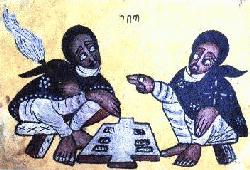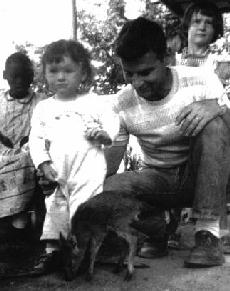
TROUBLE: Harcourt Brace (c) 1997, illustrated by Durga Bernhart
A story set in Eritrea (based on a traditional tale)
about a boy who keeps getting into trouble. His
father finds the solution: a gebeta game.
"From Kurtz comes the lively Eritrean story of a young boy with a magnetic attraction to trouble....Bernhard's illustrations provide an enchanting window into the culture and people of Eritrea." (Kirkus)
"...a lively Eritrean story of a young boy with a magnetic attraction to trouble. Bernhard's illustrations provide an enchanting window into the culture and people of Eritrea." Kirkus
"Time and place will prove no barrier to kids' identification with an inadvertent mischief-maker." The Bulletin
"Although this story will be useful for classes studying Africa, Tekeleh also has a universal appeal that should be popular with young listeners everywhere." Booklist
A Junior Library Guild selection
 Traditional Ethiopian art showing men playing gebeta
Traditional Ethiopian art showing men playing gebeta |
--The game played by the boy in the story is played on every continent. Most commonly, here in the U.S., it's called mancala. Jane says that she remembers playing it when she was a girl and recently re-learned when her eight neices and nephews in Minneapolis taught her daughter how to play. Try playing the game for a day and see if it keeps you out of trouble.
--A school in Sebeka, Minnesota, did a class activity where everyone in the classroom started a piece of writing with the first line from TROUBLE (but using his or her own name). "Trouble always found _______." Can you write about what happens when trouble finds you?
--Eritrea is one of the newest countries in the world. What can you find out about it?
--When Jane submits her stories, they are just words typed on a page. No one really knows what the pictures are going to look like until the book comes out. Contact her if you would like a copy of the story to do your own illustrations. Then, when the book comes out in March, you can compare what you saw in your mind with what Durga Bernhard, the illustrator, saw when she read Jane's story.
--Read a traditional version of this story in the book Fire on the Mountain, a collection of folktales gathered by Harold Courlander (Henry Holt, 1950). What's the same? What's different?
--Jane says, "Some kids just seem to be naturally good. And some really have trouble staying out of trouble. I was one of the kind that had trouble staying out of trouble. When I was very small, we had a rug in our house that was made from the skin of a monkey that has long black-and-white hair. I thought it was so beautiful, that one day I cut off a chunk of the hair. I have this image of myself as a little girl--my dad is looking down at me saying, "Janie, did you take some hair from the rug?" I'm shaking my head no, but my fist is tightly closed behind my back and black-and-white hair is sticking out from either side."
--Look at some of the other books Durga has
illustrated, including A Ride on Mother's Back and The
Way of the Willow Branch (both Harcourt) and see if
you can imagine what the art might look like for
TROUBLE. That's what Jane did!


Children's illustrations of TROUBLE
--The artist for TROUBLE has slipped in all kinds of visual jokes and bits of information (for example, a map at the front so you can follow Tekeleh's travels). On the cover of the book, do you see two spots of trouble? No, one of them isn't the goat sniffing the lizard.
 Men in Malawi playing a variation of the gebeta game |
--How have maps changed since Eritrea became an independent country? Compare a map made in the mid- 1980s (or before) with a map made in the 1990s.
 In visits to schools, Jane shows how many things from her books come out of her real life. For example, she shows students this picture of herself as a girl with a dik-dik that she and her sisters were able to keep as a pet for a little while. "The memory of that shy and delicate animal stayed with me," she says, "and I loved being able to put it in one of my books." |
--In one of the schools where Jane was a speaker, the students had fun designing their own lizards to go along with her book, TROUBLE. There is an Ethiopian saying that goes something like this: "The lizard eats flies on the wall of the house of the rich man and poor man alike." Can you tell what the proverb is trying to express? Collect wise sayings from as many different countries as you can find.
--Africa (Eyewitness Books) by Yvonne Ayo (Dorling Kindersley) has a good
photograph of a mancala game, as well as other interesting photographs of
things from Africa.